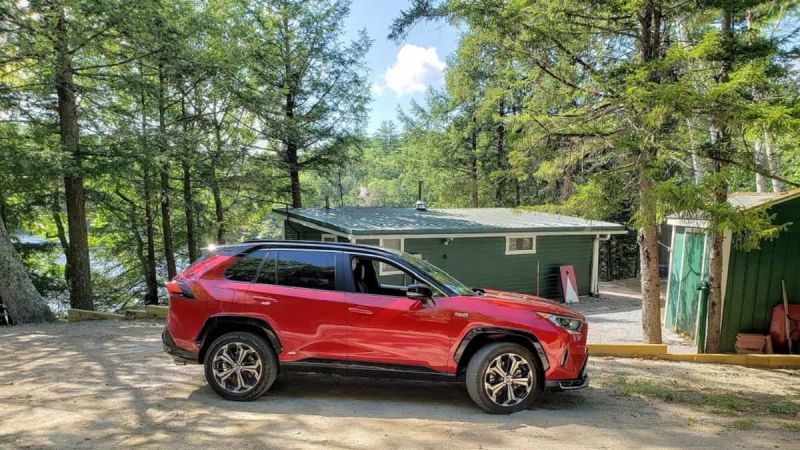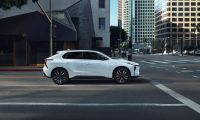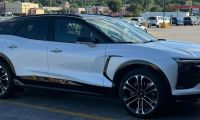The Toyota RAV4 Prime plug-In hybrid-electric vehicle (PHEV) launched in the United States at the very end of July during the worst possible time in history to launch a new vehicle. With the pandemic still taking thousands of lives each month, and new cases still trending up in key markets, buyers were wary of any shopping that was not critically necessary. Yet, despite this terrible climate in which to launch, Toyota's RAV4 Prime's delivery pace was significantly faster than many other green vehicles now considered success stories.
RAV4 Prime Delivery Data
Toyota replied instantly when Torque News requested a detailed breakdown of the U.S. deliveries of the RAV4 Prime. The first delivery was dated 7-27-2020. In its first 9.5 weeks of sales (basically two months), Toyota put 960 RAV4 Primes into the driveways of new owners. Concurrent with that, Toyota separately delivered 33,635 RAV4 Hybrids in case you wondering if the Hybrid buyers shied away knowing the Prime trim was coming. They did not.
Tesla Delivery Data - Model S, Model X, Model 3
To gain an understanding of how quickly Toyota delivered its first thousand or so RAV4 Prime PHEVs, we compared the ramp in delivery rate to some vehicles that most green car enthusiasts would agree were successes in the marketplace. First we looked at Tesla, the favorite brand of many battery-electric vehicle fans.
The Model S launched in America in June of 2012. It was Tesla's first vehicle that was not a conversion of a Lotus. This new model took seven months to reach 960 units sold. We are not trying to compare this directly to the launch of the RAV4 Prime. It is just one part of the overview.
The Tesla Model X launched in September of 2015. It took Tesla longer to reach 960 units delivered for this third model than it did the Model S. The Model X was a disaster of a launch. It took three months for Tesla to even break double-digit sales. In total, it took Tesla 7 months before it delivered 960 Model X minivans. Tesla swore it had learned all the lessons needed to launch its most important product, the upcoming Model 3 sedan in a more appropriate manner.
Related Story (2015) - Failure to launch- Tesla has delivered 15 Model X vehicles in 3 months
The Tesla Model 3 launched in July of 2017. By this point in time, Tesla had produced three prior vehicle models and was a 14-year old company with billions in public financing. It took Tesla a bit more than five months to deliver 960 vehicles. So, Toyota's RAV4 Prime run rate was more than double the Tesla Model 3's in its first months of deliveries. It is hard to argue that the Tesla Model 3 is not the world's most successful electric vehicle.
Chevy Volt and Chevy Bolt Delivery Ramp vs. Toyota RAV4 Prime
Tesla is not the only green vehicle manufacturer to slow-walk intial launches. When Chevy first debuted the Volt PHEV in December of 2010 (known back in the old days an EREV), it took this global manufacturing leader three months to deliver 960 Volts.
When GM launched the Bolt BEV in December of 2016, its launch was more impressive than all the prior green vehicle launches in history (with the possible exception of the Prius). It took GM just two months to deliver 960 Bolts. Our guestimate is that it was about 7 weeks, but Mfgs don't break deliveries down by weeks. So, our estimate is that the Bolt and RAV4 Prime had very similar delivery paces at launch.
Nissan Leaf Gen 1 and Leaf Gen 2 Ramp vs. Toyota RAV4 Prime
It took Nissan about six months to deliver 960 Leafs back in late 2010 and early 2011. The second-generation Leaf debuted in Q2 of 2018. It is hard to say exactly how many were delivered in what span of time since the Leaf Gen 1 deliveries are mixed in. But in January of 2018 Nissan only delivered 150 total Leafs.
One last Comparison - Mitsubishi Outlander PHEV vs. Toyota RAV4 Prime Deliveries
Through the end of September, Mitsubishi has delivered 947 Outlander PHEVs. Toyota's RAV4 Prime delivery rate is more than triple that of this green crossover model which has been in the marketplace for over two model years.
Why No Tesla Model Y Comparison?
Torque News reached out to the Tesla media support team and asked for the U.S. delivery history of the Model Y crossover which launched in late Q1 of this year. That data is known to Tesla and no longer secret in any way. We were unable to find any other reliable source of U.S. delivery data for the Model Y, or any official Tesla delivery data broken down by month and model. Tesla has a long history of obscuring its delivery data. Our usual third-party sources for such data, notably InsideEVs, stopped the hard work required to tease this information out of RMV records when EVs total sales began to decline last year. So, without a source, we cannot comment on the Model Y's launch volumes. As usual, Tesla opted not to participate in any sort of analysis of its deliveries in the U.S.
Toyota RAV4 Prime Delivery Expectations Going Forward
With a U.S Presidential election cycle about to hit in the midddle of this present quarter, we would expect Toyota to purposefully restrict its RAV4 Prime sales to some degree. Affordable EVs sell better when they benefit from massive tax benefits and without any clarity on the future of the incentives, all manufaturers seem to be slow-walking their new green vehicles. Honda, Hyundai,and Kia have all kicked their crossover PHEV model launches in to 2021. We would expect Toyota to continue to deliver about 500 RAV4 Primes per month until year's end, and then we can better forecast the green vehicle delivery volumes in early 2021.
Summary - Toyota's RAV4 Prime Launch Among the Most Robust In EV History
What is not in question is that the green vehicle media who favor battery-electric vehicles seized on a set of "talking points" to diminish the success of the hot Toyota RAV4 Prime. The RAV4 Prime has been launched at a rate that is faster than almost every green vehicle in history, yet the green vehicle media continues to sideline the success of the vehicle by falsely pretending its volume of delivery is less than would normally be expected. Tesla-advocacy publication, Elektrek, called Toyota's delivery schedule of 5,000 units in 2020 as "laughable." Yet, 5,000 units of a new EV is a pace that is among the fastest in green vehicle history.
Toyota's transparent sharing of delivery data is just one example of how the truth of the matter is often ignored in favor of an agenda by those green vehicle advocates who see only one type of vehicle as a soluton to a problem Toyota has been tackling longer than any other manufacturer.
For historical sales data of EVs, we suggest InsideEvs. Some of the data in this story were pulled from this valuable reource.
John Goreham is a long-time New England Motor Press Association member and recovering engineer. Following his engineering program, John also completed a marketing program at Northeastern University and worked with automotive component manufacturers. In addition to Torque News, John's work has appeared in print in dozens of American newspapers and he provides reviews to many vehicle shopping sites. You can follow John on Twitter, and view his credentials at Linkedin
Hover mouse over image to see photo credits












Comments
We're comparing PHEVs to EVs
Permalink
We're comparing PHEVs to EVs now?
Gimme a break
What's wrong with that? They
Permalink
In reply to We're comparing PHEVs to EVs by KB (not verified)
What's wrong with that? They have similarities and differences. They are both considered green by some. Others only want BEV's.
Imagine comparing 250k, 115k
Permalink
Imagine comparing 250k, 115k and 175k $ vehicles sales to a Toyota Rav4 LOL
I just looked up the EV range
Permalink
I just looked up the EV range on the prime. 42 miles! Whoopie! What a joke. Why would anyone buy a PHEV? You get limited EV range and one on the most incredibly complex engines. I have a 7 year old Toyota RAV 4 EV. Toyota was forced sell 2,600 units in California and they hated it. The car has worked great for seven years. I commuted 100 miles per days for five of those years. Plugged in at home at night. When is Toyota going to release a real RAV 4 EV???
Without getting lost in the
Permalink
In reply to I just looked up the EV range by Tim Sylvester (not verified)
Without getting lost in the specs, customers are lining up at dealerships, ordering in advance, and paying MSRP or higher to obtain RAV4 Primes. The RAV4 Hybrid is selling in volumes higher than most mainstream crossovers from competing brands. Toyota is filling customer demand for greener, faster, lower-maintenance crossovers that earn Top Safety Pick safety ratings that consume dramatically-reduced hydrocarbons. Call it a joke if you like.
Why is 42 miles EV range
Permalink
In reply to I just looked up the EV range by Tim Sylvester (not verified)
Why is 42 miles EV range useful? Many people choose to live close to where they work. Crazy right? I commute 20 miles a day and a 40 mile PHEV is perfect. Always EV for daily drives, without the range anxiety on occasional long trips. And without the environmental impact of a huge battery I don’t need. The truth is, a PHEV with just enough range for one’s daily commute is FAR better for the environment than an all electric car, but nobody is smart or honest enough to advertise this.
Well said, Jonathan. Another
Permalink
In reply to Why is 42 miles EV range by Jonathan Birge (not verified)
Well said, Jonathan. Another way to answer Tim's question is that 42 EV miles per day equals 15,330 miles per year. More than the average driver covers in total miles annually. And when one needs to make a long trip one never needs to charge if that would be inconvenient., impractical, or impossible. In our testing, we saw a 45 MPG real-world mileage when testing the all-wheel-drive RAV4 Prime with the AC on the entire trip. And it drives like an EV, even when the EV-mile meter is at zero. It is nice to see the BEV owners in the comments section asking questions.
So dense that claim has been
Permalink
In reply to Why is 42 miles EV range by Jonathan Birge (not verified)
So dense that claim has been repeatedly debunked even in the worst coal states. If anyone did an ounce of research they would see how stupidly wrong your last statement is. But you don't want to be honest.........
Calm down, bud. I’m not
Permalink
In reply to So dense that claim has been by Socaby (not verified)
Calm down, bud. I’m not saying EVs aren’t better for the environment than ICE cars, which is what was debunked. I’m saying if 98% of your drives are less than 40 miles, your environmental break even point comes earlier in the life of the car with a small battery EV (or plug in hybrid, if you don’t use the engine much).
Very strange cherry picking
Permalink
Very strange cherry picking of data.
I'm shocked, a car company
Permalink
I'm shocked, a car company that was founded 83 years ago can make vehicles faster than one that's been around 14 years and barely past being a startup.
Compare Tesla's previous year sales and Toyota's previous year sales of all models. How does the new model compare to the number of vehicles they normally produce?
I understand your point. But
Permalink
In reply to I'm shocked, a car company by John Lauro (not verified)
I understand your point. But in the story, we did not limit the comparison. We compared the initial launch volumes of every successful EV, and also included data on the closest match to the RAV4 Prime, the Outlander PHEV. GM, Nissan, and Mitsubishi are included in the story. Everyone but Ford and Honda, who have opted not to launch their PHEV crossover this year (to our surprise). Tesla has created the most successful EVs. So, of course, they set the benchmark for launches of such vehicles. Tesla turned seventeen last July.
Well it is a very odd
Permalink
Well it is a very odd comparison of numbers. Not the fact that you are comparing PHEVs to EVs, because I don't care about that distinction. But comparing the sales rates of the first, pioneering EVs, many years ago, with Toyota's RAV4 Prime PHEV in today's totally different market of 2020. Each of Tesla's models were new the year that they debuted, but Tesla had to work over a decade to get the worldwide acceptance that they enjoy now. Toyota already had built their RAV4 Hybrid, and certainly they had been planning for the Prime model many years ago. So regardless if you look at Toyota's fast RAV4 prime deliveries either from a production point of view, or from a buyer's acceptance point of view, they were ready for volume production, and had buyers chomping at the bit to get them. If Toyota had not limited production of the prime model to 5,000 units, and if they had the same $3,500 price difference as the Prius has with the Prius Prime PHEV, then I'd bet that their sales numbers would be at least double of these numbers. The fact that Tesla shipped over 124,000 Model 3s and Model Ys worldwide from July to September this year shows the larger EV sales potential overall. Even though it's not apples to apples. I am happy that Toyota is offering the RAV4 Prime, but they could have made it a market-shaking success, if they had handled it better.
Listen, I like Tesla but not
Permalink
Listen, I like Tesla but not crazy about the rediculous stock price. I was hoping your write up would provide insight showing why it's overpriced, but it didn't. Terrible article, terrible comparisons. BS switch and bait.
My Toyota dealer in Ohio
Permalink
My Toyota dealer in Ohio hardly payed any attention when I asked about the Rav Prime, and kept assuring me they would be available “soon.”. Having transitioned from a Volt to a Bolt and being comfortable with all EV, I got sick of waiting. Picked up my model Y last week. It’s a dream, and much more comfortable than the Bolt for my husband, who has intermittent back pain.
1) PHEV vs EV not the same.
Permalink
1) PHEV vs EV not the same.
2) Different class of cars
3) different price points.
A very sad attempt to dismiss the success of Tesla in a disingenuous way. Maybe when they put out a full EV that compares we can discuss. They need that engine in there so stealerships can still make money on servicing. What happened to the hydrogen revolution Toyota? Still waiting........
Worst time in history lol,
Permalink
Worst time in history lol, have a short attention span when articles start off with such bold allegations
Great article. it would be
Permalink
Great article. it would be nice if there was an update
thanks
Thanks, Mark! I'm planning
Permalink
In reply to Great article. it would be by Mark (not verified)
Thanks, Mark! I'm planning one for late next week. And I am crossing my fingers that Toyota didn't sell seven of these things in the past three months. I'll write it either way!
Pagination